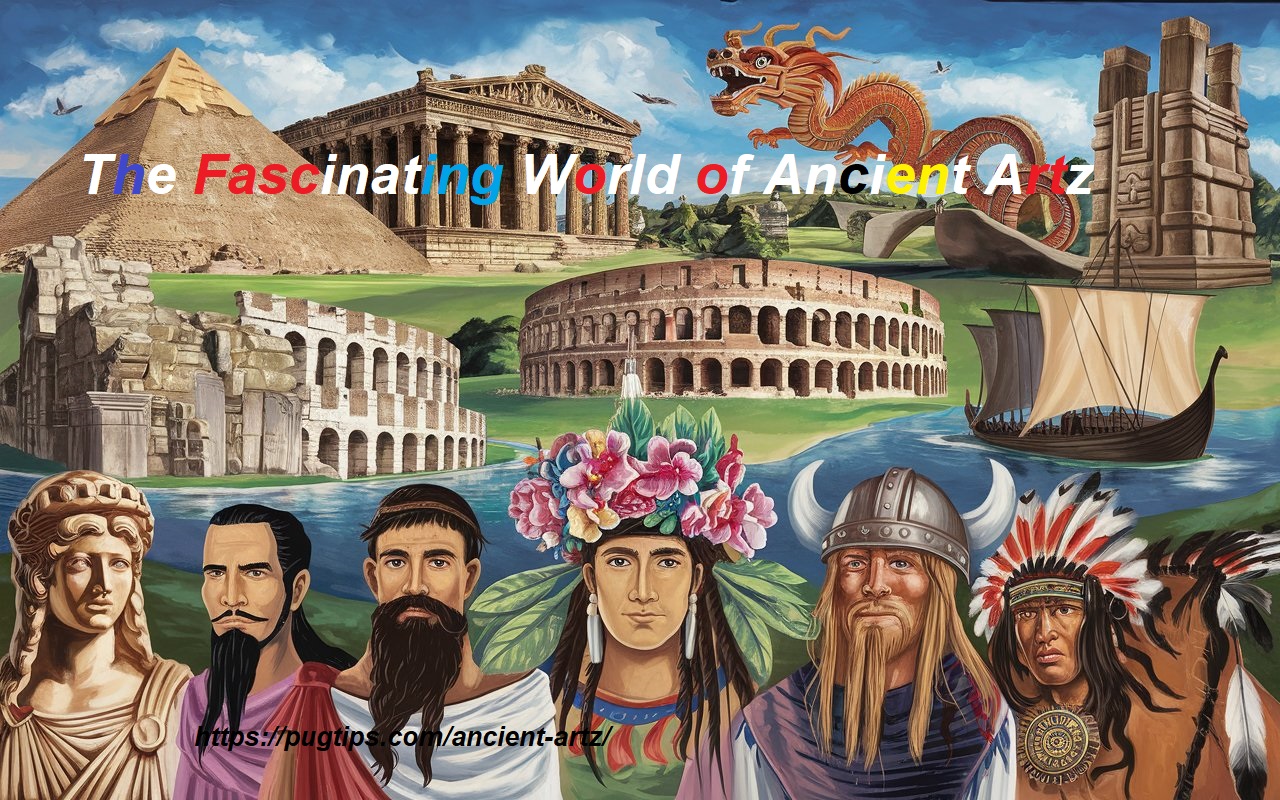Outline Of Ancient Artz:
Explore the fascinating world of Ancient Artz, uncovering the cultural heritage and artistic achievements of ancient civilizations.
| Heading | Sub-headings |
|---|---|
| Introduction to Ancient Artz | – What is Ancient Artz? – The Significance of Ancient Art |
| Ancient Artz in Early Civilizations | – Mesopotamian Art and Architecture – Egyptian Art: Symbols of Eternity |
| Classical Artz of Greece and Rome | – The Rise of Classical Greek Art – Roman Artistic Influences |
| Asian Contributions to Ancient Art | – The Intricacies of Ancient Chinese Art – Indian Art: Spiritual and Symbolic Creations |
| Religious and Mythological Themes in Ancient Artz | – Art as a Reflection of Belief Systems – Depictions of Gods and Myths |
| The Evolution of Ancient Art Techniques | – Early Tools and Materials Used – Innovations in Sculpture and Pottery |
| Iconography in Ancient Artz | – Symbolism and Meaning – The Role of Color and Composition |
| Preservation of Ancient Art | – Efforts to Conserve Cultural Heritage – Challenges in Protecting Ancient Artifacts |
| The Influence of Ancient Art on Modern Culture | – Revival of Ancient Techniques – Inspirations in Contemporary Art |
| The Global Legacy of Ancient Artz | – Museums and Collections – Archaeological Discoveries Impacting Art |
| Ancient Artz FAQs | – What defines Ancient Artz? – How did ancient artists create sculptures? – Why are religious themes prominent in ancient art? – How is ancient art preserved today? – What are the most famous ancient art pieces? – Can we still learn from ancient art today? |
The Fascinating World of Ancient Artz
Ancient Artz offers a window into the diverse and dynamic cultures of the past, showcasing the brilliance of early civilizations through their creative expressions. These works are not just artifacts; they are the echoes of human history, documenting beliefs, values, and the evolution of society. Whether through the intricate carvings on ancient temples or the symbolic frescoes adorning burial chambers, ancient art provides insights into how early humans interpreted the world around them.
What is Ancient Artz?
Ancient art refers to the creative endeavors produced by early civilizations, often dating back thousands of years. This art form includes various mediums such as sculpture, pottery, paintings, jewelry, and architecture. What distinguishes ancient art from later forms is its deep connection to religious, social, and cultural practices. These works were often created with specific purposes in mind, such as honoring deities, commemorating rulers, or celebrating natural phenomena.
The Significance of Ancient Artz
Ancient artz holds immense cultural and historical significance, representing the ideologies and innovations of early societies. Each artifact or artwork tells a story about the civilization that created it, whether it’s the monumental pyramids of Egypt or the delicately carved pottery of ancient Greece. By studying ancient art, historians and archaeologists can piece together details about ancient daily life, religious practices, political systems, and technological advancements.
Ancient Artz in Early Civilizations
Mesopotamian Art and Architecture
The ancient civilization of Mesopotamia, located between the Tigris and Euphrates rivers, is often referred to as the “cradle of civilization.” The art produced in this region reflects their highly organized society and deep connection to religion. Mesopotamian artists created monumental sculptures of gods and rulers, intricate carvings, and architectural marvels such as the ziggurats—massive terraced structures that functioned as temples.
Their art was typically characterized by its functional purpose, with many sculptures and carvings made to accompany religious rituals or serve as protection for homes and cities. One of the most iconic pieces of Mesopotamian art is the Stele of Hammurabi, which features one of the earliest known legal codes.
Egyptian Art: Symbols of Eternity
Egyptian art is perhaps one of the most recognizable and enduring legacies of ancient civilizations. Known for its symbolic representation of the afterlife and the divine, Egyptian art was deeply intertwined with the belief in immortality. This is most evident in their monumental architecture, such as the Great Pyramids, and in the intricate tomb paintings found in the Valley of the Kings.
Egyptian artists used a highly stylized and formulaic approach, where figures were depicted with an idealized, almost divine, perfection. The use of hieroglyphs, the detailed carvings, and the elaborate jewelry and sculpture created during this time continue to captivate modern audiences, shedding light on the Egyptians’ spiritual views and royal life.
Classical Artz of Greece and Rome
The Rise of Classical Greek Art
The classical art of ancient Greece revolutionized the way humans depicted the human body and their surrounding world. Greek artists were renowned for their pursuit of idealism, symmetry, and proportion, which are all exemplified in their sculptures. The Greeks developed three distinct artistic periods—Archaic, Classical, and Hellenistic—each marking an evolution in their creative techniques.
The iconic statues of athletes, gods, and heroes, such as the Discobolus (The Discus Thrower), represent not only physical beauty but the human potential for greatness. Greek architecture, notably the Parthenon, also highlights the Greeks’ mastery of balance and proportion.
Roman Artistic Influences
Roman art, while heavily influenced by Greek traditions, brought its own innovations and practical applications. The Romans were exceptional architects, engineers, and realists in their artistic expressions. Their sculptures, murals, and mosaics often depicted historical events, everyday life, and powerful political figures. One of the crowning achievements of Roman architecture is the Colosseum, a monumental amphitheater designed for public spectacles.
Roman artists excelled in portraiture, often creating highly detailed and lifelike busts of emperors, philosophers, and military leaders. Their art aimed to immortalize the grandeur of Rome and its rulers, blending realism with idealism in a manner that has influenced Western art for centuries.
Asian Contributions to Ancient Artz
The Intricacies of Ancient Chinese Art
The art of ancient China is distinguished by its technical mastery, spiritual depth, and symbolic significance. From the intricately crafted jade figurines of the Neolithic period to the awe-inspiring terracotta army of the First Emperor, Chinese artists have long focused on expressing harmony with nature and the divine. Calligraphy, an essential component of Chinese art, is often viewed as a spiritual practice, where the artist’s brushwork reflects their inner self.
Chinese painting, often executed on silk or paper, depicts natural landscapes, mythical creatures, and historical events with a profound sense of balance and serenity. Ceramics, particularly during the Tang and Song dynasties, represent another pinnacle of Chinese artistry, with fine porcelain becoming a highly sought-after commodity throughout the ancient world.
Indian Art: Spiritual and Symbolic Creations
In India, ancient art is deeply rooted in spirituality and the representation of the divine. Early Indian art was often religious in nature, with sculptures and paintings designed to glorify gods such as Vishnu, Shiva, and Buddha. The temples of Khajuraho, adorned with intricate carvings depicting both human and divine forms, are a testament to the Indian mastery of stone sculpting.
Indian art also spans diverse regions and periods, with influences from Hinduism, Buddhism, and later Islamic traditions. The art of ancient India not only tells stories from sacred texts but also conveys philosophical ideas, offering a unique glimpse into the metaphysical worldviews of ancient Indians.
Religious and Mythological Themes in Ancient Artz
Art as a Reflection of Belief Systems
Religious and mythological themes dominate ancient artz, reflecting the central role that deities and spiritual beliefs played in shaping early societies. Art was often used as a form of worship, with temples, altars, and sculptures dedicated to gods and goddesses. For example, the ancient Greeks created numerous statues and reliefs depicting their pantheon of gods, while the ancient Egyptians adorned their temples with depictions of deities such as Ra and Osiris.
Religion influenced not only the subject matter but also the style and form of the art, with many civilizations using specific colors, symbols, and motifs that carried spiritual significance. For instance, the lotus flower in both Egyptian and Indian art symbolizes purity and enlightenment.
Depictions of Gods and Myths
Ancient artz offers a vivid portrayal of the gods, goddesses, and mythological stories that were central to the spiritual and cultural lives of early civilizations. These depictions often served a dual purpose: not only were they used in religious rituals, but they also helped explain the mysteries of the world to the people of the time. For example, in ancient Greece, the sculptors Phidias and Praxiteles created towering statues of gods like Zeus and Athena, which were placed in temples as objects of veneration.
Similarly, Mesopotamian art is filled with representations of divine figures such as Ishtar, the goddess of love and war, and Marduk, the supreme god of Babylon. These works often depicted scenes from creation myths or heroic tales that showcased the power of the gods over humanity. Egyptian tomb art, filled with images of gods like Anubis and Horus, aimed to ensure a safe passage into the afterlife. In this way, art was not merely decorative; it was a tool of religious expression and communication with the divine.
The Evolution of Ancient Art Techniques
Early Tools and Materials Used
The tools and materials used by ancient artists were surprisingly sophisticated, considering the limited technology available at the time. Many ancient artists used natural materials like stone, clay, and wood, which were readily available in their environments. In places like ancient Egypt, artists worked with precious metals and gemstones to create elaborate jewelry, while Greek sculptors perfected the art of chiseling marble into life-like forms.
The choice of material was often dictated by the artwork’s purpose. For instance, clay tablets in Mesopotamia were used for cuneiform inscriptions, while bronze was popular for casting durable statues in ancient Rome. Ancient Chinese artists were known for their mastery in working with jade, considered the “stone of heaven,” and used in both ceremonial and artistic contexts. As techniques advanced, artists began experimenting with more complex processes, such as bronze casting, which allowed for more detailed and dynamic sculptures.
Innovations in Sculpture and Pottery
One of the most significant innovations in ancient art was the development of new sculpting techniques, which allowed for greater expression and realism. In ancient Greece, the transition from the stiff and formalized poses of the Archaic period to the fluid, naturalistic forms of the Classical period marked a major evolution in sculptural technique. This shift is exemplified by masterpieces like the Venus de Milo and the Doryphoros, which display an unprecedented understanding of human anatomy and movement.
In addition to sculpture, pottery became a vital form of artistic expression in ancient cultures. Pottery was not only functional but also a canvas for intricate designs and stories. Greek vase painting, for instance, often depicted scenes from mythology, daily life, and athletics. These vases were prized for their aesthetic beauty and craftsmanship, as well as for their ability to convey complex narratives. Ancient China, too, developed its own distinct pottery style, with the creation of highly coveted porcelain during the Tang and Song dynasties.
Iconography in Ancient Artz
Symbolism and Meaning
Ancient artz is filled with symbolism, where every shape, color, and figure carries a deeper meaning. Understanding these symbols can unlock the stories and beliefs embedded in the artwork. For example, in Egyptian art, the ankh symbol represents life, while the scarab beetle is a symbol of rebirth and protection. The Greeks used the olive branch as a symbol of peace and victory, and in Mesopotamian art, winged creatures were often symbols of divine power and protection.
Animals also played a significant role in ancient iconography. The lion, for instance, was a powerful symbol in many ancient cultures, representing strength, royalty, and protection. In Chinese art, the dragon is a symbol of power, strength, and good fortune, while the phoenix represents immortality and resurrection. These symbols helped convey complex ideas in a visual form that could be easily understood by the people of the time.
The Role of Color and Composition
Color was another important element in ancient art, often imbued with symbolic meaning. In ancient Egypt, artists used specific colors to represent different aspects of life and death. Green, for example, symbolized fertility and rebirth, while red represented chaos and disorder. Gold, the color of the sun, was associated with the gods and the eternal. Similarly, in ancient China, red was a symbol of good fortune and joy, while black represented water and wisdom.
Composition, or the arrangement of elements within a work of art, was carefully considered by ancient artists to achieve balance and harmony. In Greek art, the concept of symmetry and proportion was crucial, and artists adhered to mathematical principles like the Golden Ratio to create aesthetically pleasing designs. In other cultures, such as in Indian temple art, composition was used to guide the viewer’s eye through a spiritual journey, with figures arranged in a way that conveyed the cyclical nature of life, death, and rebirth.
Preservation of Ancient Art
Efforts to Conserve Cultural Heritage
The preservation of ancient artz is a critical task that involves conserving priceless artifacts and preventing further deterioration. Over the centuries, ancient art has faced threats from natural decay, looting, wars, and environmental factors. However, modern preservation techniques, along with growing international efforts, have helped protect these treasures. Museums around the world have taken up the challenge of restoring ancient works, from crumbling frescoes to eroded sculptures, using state-of-the-art technologies such as laser cleaning and 3D imaging.
Organizations such as UNESCO have also played a pivotal role in preserving cultural heritage sites. The designation of World Heritage Sites helps to ensure the protection of places like the ruins of ancient Rome, the temples of Egypt, and the Great Wall of China. Archaeological excavations, combined with conservation initiatives, have brought many ancient works of art back into public view, allowing us to study and appreciate them in new ways.
Challenges in Protecting Ancient Artifacts
Despite these efforts, the preservation of ancient art remains a complex challenge. Environmental factors such as pollution, climate change, and natural disasters pose significant threats to fragile artifacts. Additionally, the illegal trade in antiquities continues to be a major problem, with looted artifacts often ending up on the black market. Political instability and conflict in regions with rich cultural histories, such as the Middle East, have also led to the destruction of priceless works of art.
Efforts to combat these challenges include international agreements aimed at preventing the illicit trafficking of cultural property and initiatives to raise public awareness about the importance of preserving ancient art. Collaborations between governments, museums, and academic institutions are essential in ensuring that future generations can continue to experience and learn from these ancient masterpieces.
The Influence of Ancient Art on Modern Culture
Revival of Ancient Techniques
Ancient artz has had a profound and lasting influence on modern art, with many contemporary artists drawing inspiration from the techniques and styles of ancient civilizations. The Renaissance period, for example, saw a revival of classical Greek and Roman art forms, with artists like Michelangelo and Leonardo da Vinci studying ancient sculptures to perfect their own techniques. Today, modern sculptors, painters, and architects continue to reference ancient methods, using them as a foundation for creating new and innovative works.
One of the most significant areas where ancient art continues to influence modern culture is in the field of architecture. Classical Greek and Roman architectural elements, such as columns, domes, and arches, are still used in contemporary buildings around the world. The principles of symmetry and proportion that were developed by ancient Greek architects remain fundamental to modern design.
Inspirations in Contemporary Art
Many modern artists find inspiration in the themes, symbols, and stories depicted in ancient artz. From the minimalist sculptures of the 20th century to abstract interpretations of ancient mythologies, the legacy of ancient art continues to be a rich source of creative energy. For instance, the Surrealist movement, led by artists like Salvador Dalí, often drew on ancient mythological themes, reinterpreting them through the lens of modern psychology.
In addition, the use of traditional materials and techniques from ancient cultures can be seen in modern craft movements. Ceramicists, weavers, and metalworkers continue to use age-old methods passed down through generations, blending them with contemporary aesthetics to create works that honor the past while pushing the boundaries of art today.
The Global Legacy of Ancient Artz
Museums and Collections
Today, ancient art is housed in museums and private collections around the world, where it continues to captivate and educate the public. Iconic institutions such as the British Museum, the Louvre, and the Metropolitan Museum of Art contain vast collections of ancient artifacts, from Greek vases to Egyptian mummies. These museums play a crucial role in preserving ancient art and making it accessible to a global audience.
Exhibitions of ancient art offer visitors a unique opportunity to engage with history and culture in a tangible way, allowing them to see firsthand the incredible craftsmanship and creativity of early civilizations. In recent years, the digitalization of museum collections has further expanded access, with online galleries and virtual tours making it possible for people around the world to explore ancient art without ever leaving their homes.
Archaeological Discoveries Impacting Art
Ongoing archaeological discoveries continue to reshape our understanding of ancient artz. Excavations in places like Pompeii, Egypt, and Mesopotamia have unearthed countless new artifacts, providing fresh insights into the artistic practices of these civilizations. For example, the discovery of the Terracotta Army in China in 1974 revealed a previously unknown level of craftsmanship and artistic sophistication, showcasing the grandeur of ancient Chinese art.
These discoveries not only expand our knowledge of the past but also inspire new generations of artists and scholars. The influence of ancient art on fields such as archaeology, anthropology, and art history is immeasurable, and as more treasures are unearthed, the story of ancient art continues to evolve.
Ancient Artz FAQs
What defines Ancient Artz?
Ancient artz refers to the creative works produced by early civilizations, often serving religious, political, or social functions. These works are typically created with materials like stone, clay, and metal and are deeply connected to the cultural and spiritual beliefs of the time.
How did ancient artists create sculptures?
Ancient artists used a variety of tools, including chisels, hammers, and knives, to carve stone and shape materials like clay and metal. Some advanced techniques, such as bronze casting and marble sculpting, were developed to create more intricate and realistic forms.
Why are religious themes prominent in ancient art?
Religion played a central role in the lives of ancient peoples, and art was often used to express devotion, depict gods and goddesses, and honor spiritual beliefs. Many artworks were created for use in temples or as offerings to deities.
How is ancient art preserved today?
Ancient art is preserved through a combination of conservation techniques, including cleaning, restoration, and climate control. Museums and international organizations work together to protect ancient artifacts from damage caused by environmental factors and human activity.
What are the most famous ancient art pieces?
Some of the most famous ancient art pieces include the Great Pyramids of Egypt, the Parthenon in Greece, the Terracotta Army of China, and the Colosseum in Rome. These works are renowned for their historical significance and artistic achievement.
Can we still learn from ancient art today?
Yes, ancient art continues to offer valuable insights into the cultures, beliefs, and technologies of early civilizations. It also serves as a source of inspiration for modern artists, architects, and designers, who often look to ancient works for guidance on aesthetics, technique, and symbolism.
Conclusion
Ancient artz offers us a fascinating glimpse into the minds and hearts of early civilizations. These works of art, created thousands of years ago, remain relevant today, as they continue to inspire and educate us about the human experience. By preserving these masterpieces and studying their meanings, we not only honor the past but also ensure that the legacy of ancient art endures for future generations.
ALSO VISIT: The Secrets Behind Lwedninja: Uncovering the Hidden Martial Art










